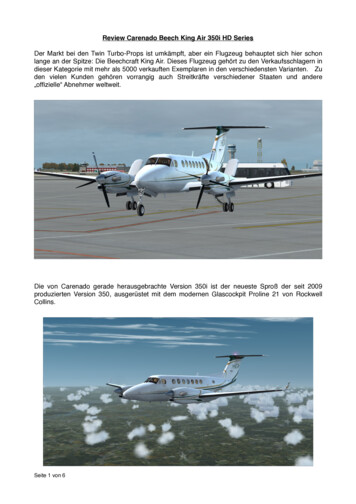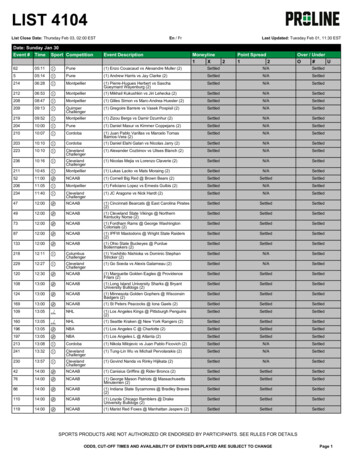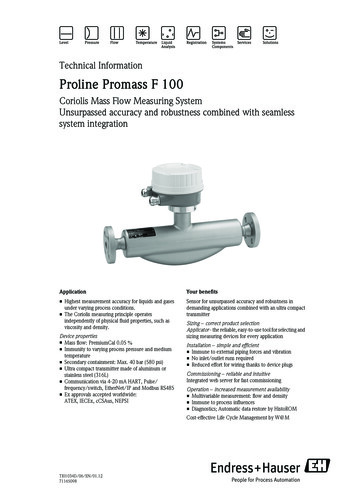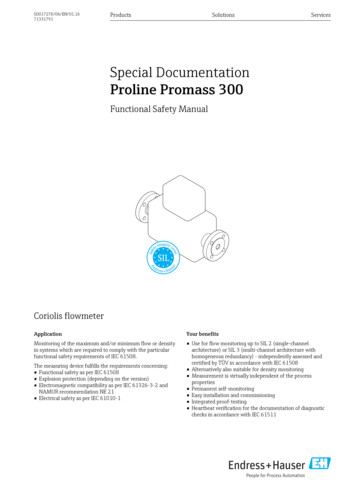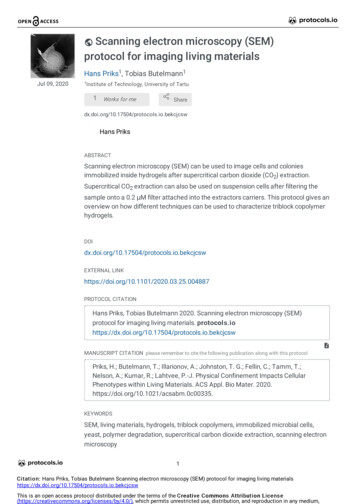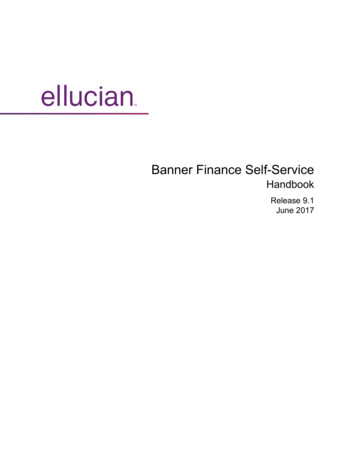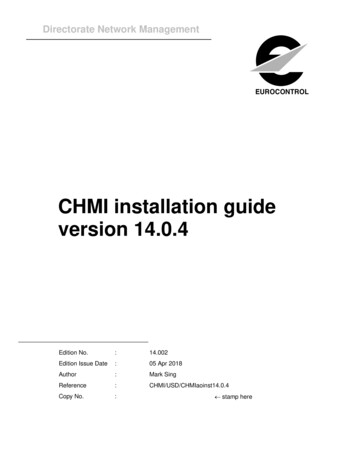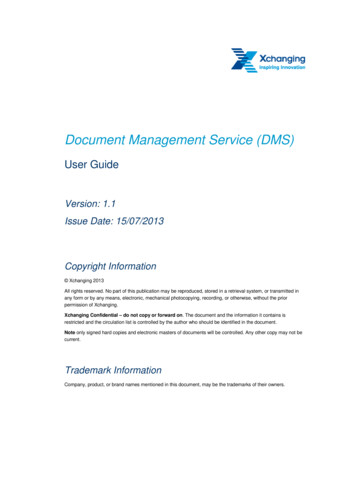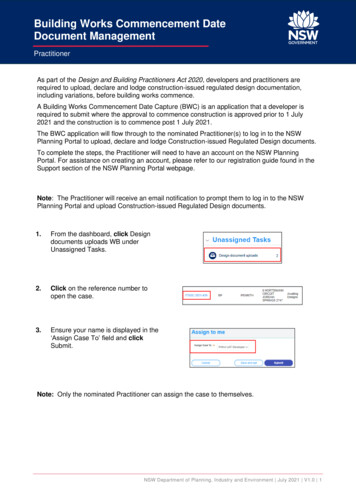
Transcription
ProLine Document eSortBest Practices for Scanning Tax Documents
Document eSortBest Practices for Scanning Tax DocumentsThis document details the best practices for scanning tax documents for use with Document eSort.You’ll learn which scanner settings provide optimal results, what detracts from quality images, and howto avoid scanning imperfections that can hinder Document eSort productivity. While this documentprovides best practices for any scanning process, we highly recommend the use of Intuit ProLine DMS.Know Your Scan SettingsThe image quality of scanned documents starts at the scanner level. If your scan settings are notoptimal for scanning tax documents, the image quality of the resulting scanned document will followsuit. Set your scan software to the following basic image specifications to ensure you always scan yourdocuments right the first time.Scan to a PDFTo create a PDF from your scanner, choose File Create PDF From Scanner in Adobe Acrobat , or any industry‐standardPDF writer. You can also choose whether you’d like to create anew document or append the scanned pages to a currentdocument.Scan at 300dpiMake sure your image settings are set to scan the documentat a resolution of 300dpi. This is not the same as scanning ata lower resolution and then saving at 300dpi. DocumenteSort may not be able to identify the text on low resolutionimages. If Document eSort cannot read the text on adocument, then it will be classified under the bookmark:“Handwritten Notes; Poor Quality”.Productivity PointScanning Simplex vs. Duplex:A simplex scanner scans oneside of a page, while a duplexscanner scans both sides atonce. If you have a duplexscanner, we recommendautomatically scanning bothsides of each document atonce, as Document eSort willcreate bookmarks for bothback pages and blank pages.Scan in Black and WhiteThough color and grayscale may look more readable to the human eye,scanning your documents in black and white will provide clearer images forDocument eSort processing – and the files will be smaller, so they’ll take up less space on your harddrive and take less time to upload to Document eSort.No Read/Write/Password ProtectionDocuments saved with read, write, or password protection cannot be processed by Document eSort. Ifyour PDF is saved with these settings, be sure to remove them before uploading to either program.
Creating the Highest Quality Images from Client Source DocumentsNow that you know what settings to use before you start scanning, it’s time to understand what you cando to achieve maximum image quality from the actual source documents and ensure documentclassification by Document eSort.Scan the Original DocumentEvery time a document is copied, the imagequality is degraded. The further removed youget from the original document, the “noisier”the document becomes.For best results, scan the original sourcedocument, as received by the client. Avoidusing copies of client documentation. Faxedcopies are particularly low quality and shouldbe avoided.This is a “noisy” document. The noise on this documentwill make it harder to read with Document eSort.Productivity PointAfter you’ve scanned your documents, give them the“Readability Test”. If your eyes are straining to read adocument, Document eSort will likely have the sameissue. Any document that cannot be read will bebookmarked as “Handwritten Notes; Poor Quality”.Scan the Document at its Original SizeFor best results, the size of the scanneddocument should correspond roughly to the sizeof the original document. Document eSortrecognizes scanned documents as large as legalsize documents, with a maximum scannedimage size of 8.5”x14”.If the size of a document is greatly reduced orexpanded when scanned, it increases thechances that the scanned image will bedistorted. A document scanned at the originalsize settings will preserve readability of thedocument and minimize distortion.Distortion may also be caused by scanningdocuments that are folded or crumpled, and bydocuments that were caught in a paper jamwhile being scanned.The above image is an example of a distorted image.This can occur when the size of the scanned documentdoes not correspond to the size of the originaldocument
Scan Multi‐Page Documents TogetherMulti‐page documents, like brokerage statementsand K‐1’s, should be submitted in logical order,where possible. Document eSort will notreassemble a multi‐page document that has beenscattered throughout an input PDF.Scan Each Document to Its Own PageIf more than one document is scanned to the samepage, only the dominant form, as determined by theDocument eSort software, will be bookmarked. ForDocument eSort users, data will not be extractedfrom either form. Visibility of the less dominantform(s) will be lost, as only one bookmark will begenerated per page.Avoid Submitting Documents with Faint or FadedTextNot all original tax documents are suitable forprocessing by Document eSort. Going back to the“Readability Test”, faint, faded text is hard to readand therefore may not be properly classified. If adocument cannot be classified, the data cannot beextracted by Document eSort.The top form shown is a W‐2; the bottomform is a 1099‐G. Document eSort willclassify only the dominant form on thispage.Productivity PointThough Document eSort canrecognize handwriting and classifyhandwritten notes as “HandwrittenNotes; Poor Quality”, it is unable toread the handwriting. Forms thatcontain important identifyinginformation that is handwritten, likethe form to the right, may not beproperly classified and will notextract tax data.This document has faint, faded text whichwill make it difficult to read and classify.
Avoid Black Backgrounds, Ink Bleeding, and SmudgingBlack backgrounds can be created by leaving the tray coveropen during single page flatbed scanning. Black backgrounds,ink bleeding, and smudging are considered “noise” and canslow Document eSort processing.Here is another “noisy”document due to ink bleedingand smudging.Avoid Submitting Clipped or Cut FormsClipped or cut forms may be missing important data thatDocument eSort needs to identify and classify the form.Other Tips and Tricks to Help You EasilyNavigate Through Document eSortNaming Your PDF Input File Do not use special characters when naming your PDF files.PDF filenames containing ampersands ( & ) and apostrophes( ‘ ) can create problems when being processed by DocumenteSort.File Size.If your PDF file size is greater than 30MB, we recommend yousplit the document into two or more PDFs before submittingfor Document eSort processing. You can upload up to fourPDF documents to Document eSort per client.Upside Down and Sideways Pages .Document eSort will automatically rotate all upside down(180o) and sideways (90o and 270o) pages to the proper pageorientation during processing. However, if a scanneddocument is skewed more than 10o from any of thesepositions, page orientation will not be corrected and data willnot be extracted.Clipped or cut forms may bemissing information thatDocument eSort needs toidentify and classify.Though Document eSort willrotate documents scanned upsidedown or at a right angle,documents that are skewed 100 ormore from absolute N, S, E, or W,will not be corrected.
Best Practices for Scanning Tax DocumentsScanning Quick Reference GuideScan Settings¾Scan to PDF¾Scan at 300dpi¾Scan in Black & White¾Do not upload files with Read/Write/Password protectionScanning Source Documents¾Scan the original tax document – avoid uploading copies and faxes¾Scan the document at its original size¾Do not upload documents larger than 8.5”x14”¾Scan multi‐page documents together, in logical order¾Scan each document to its own page¾Do not leave the tray cover open when scanning single pages on a flatbed scannerSource Documents to Avoid¾Documents with faint or faded text¾Documents that contain important identifying information that is handwritten¾Documents with ink bleeding or smudging¾Clipped or cut forms that exclude important identifying information
This document details the best practices for scanning tax documents for use with Document eSort. You'll learn which scanner settings provide optimal results, what detracts from quality images, and how to avoid scanning imperfections that can hinder Document eSort productivity. While this document

